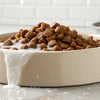Is Freeze-Dried Food Better for Dogs? Exploring the Benefits and Considerations
- Houndsy
Table of Contents
- Introduction
- Understanding Freeze-Dried Dog Food
- Benefits of Freeze-Dried Dog Food
- Considerations and Potential Drawbacks
- Incorporating Freeze-Dried Food into Your Dog's Diet
- Conclusion
Introduction
Did you know that nearly 50% of pet owners are considering alternative diets for their furry friends, with freeze-dried food gaining significant attention? This shift towards more natural feeding options reflects a growing awareness of pet nutrition and well-being. As responsible pet owners, we often grapple with the question: is freeze-dried food better for dogs? In this post, we will delve into the world of freeze-dried dog food, exploring its benefits, potential drawbacks, and how it compares to traditional kibble.
Our aim is to equip you with the knowledge to make informed decisions about your dog's diet. We will cover what freeze-dried food is, how it is made, its nutritional benefits, and the important considerations to keep in mind. As we navigate this topic, we invite you to reflect on your own pet feeding routines and how they might be improved. By the end of this post, you’ll not only understand the ins and outs of freeze-dried food but also how it aligns with the philosophy we embrace at Houndsy—elevating the dog feeding experience with innovative design and functionality.
Understanding Freeze-Dried Dog Food
To get started, let's define what freeze-dried dog food is. Freeze-drying is a preservation process that removes moisture from raw ingredients, such as meat, fruits, and vegetables, while retaining their nutritional integrity. This technique has gained popularity as pet owners seek less processed alternatives to traditional kibble and canned food.
The Freeze-Drying Process
The freeze-drying process involves three main stages:
- Freezing: The raw ingredients are first frozen to preserve their structure and nutrients.
- Sublimation: In a vacuum chamber, the frozen water in the food is converted directly into vapor, bypassing the liquid state. This gentle process avoids the high temperatures that can damage nutrients.
- Moisture Removal: Finally, gentle heat is applied to remove any remaining moisture, resulting in lightweight products that maintain their original flavor, texture, and nutritional value.
This method not only allows for extended shelf life but also retains the natural flavors that dogs love, making freeze-dried food a highly palatable option.
Nutritional Profile of Freeze-Dried Dog Food
One of the key advantages of freeze-dried food is its nutrient density. Because the freeze-drying process preserves vitamins, minerals, and enzymes, dogs receive a meal that closely mimics what they would eat in the wild. Typical ingredients in freeze-dried dog food include:
- High-Quality Proteins: Muscle meat and organ meats provide essential amino acids.
- Fruits and Vegetables: These offer natural sources of vitamins, minerals, and fiber.
- Natural Preservatives: Ingredients like tocopherols (vitamin E) help maintain freshness without artificial additives.
This combination offers a balanced nutritional profile, supporting overall health, energy levels, and vitality.
Benefits of Freeze-Dried Dog Food
Now that we understand what freeze-dried dog food is, let's dive into the specific benefits it offers to our canine companions.
1. Nutrient Retention
Unlike traditional kibble, which often undergoes extensive cooking, freeze-dried food retains most of its nutritional value. The gentle freeze-drying process ensures that essential vitamins and minerals remain intact, providing a nutrient-dense meal for your dog.
2. Enhanced Palatability
The process of freeze-drying locks in the natural flavors of the ingredients, making the food more appealing to even the pickiest eaters. This is particularly beneficial for dogs with a history of poor appetite or food sensitivities.
3. Convenience and Storage
Freeze-dried dog food is incredibly convenient. It is lightweight, requires no refrigeration, and has a long shelf life when stored properly. This makes it an ideal option for pet owners who travel frequently or have limited storage space.
4. Improved Digestion
The minimally processed nature of freeze-dried food means that it is often easier for dogs to digest compared to heavily processed kibble. Many dogs experience fewer gastrointestinal issues, such as bloating and gas, when transitioning to a freeze-dried diet.
5. Supports Weight Management
Due to its high nutrient density, freeze-dried food can help dogs feel satisfied with smaller portions. This can reduce the risk of overeating and obesity—a critical consideration for maintaining your dog's overall health.
6. Mimics a Natural Diet
Freeze-dried dog food closely resembles what dogs would naturally consume in the wild. By providing a balance of meat, organs, and some plant materials, freeze-dried food ensures that dogs receive the right levels of protein, fat, vitamins, and minerals necessary for optimal health.
Considerations and Potential Drawbacks
While freeze-dried dog food offers numerous advantages, it's important to consider some potential drawbacks before making a switch.
1. Cost
One of the significant downsides of freeze-dried dog food is its cost. The freeze-drying process is more expensive than traditional methods, which can lead to higher prices per serving. However, many pet owners find the investment worthwhile for the quality and nutritional benefits.
2. Safety Concerns
Though the freeze-drying process helps preserve food, it does not eliminate all pathogens. Raw diets, including freeze-dried options, can carry risks of bacteria such as Salmonella or E. coli. It is essential to handle, store, and serve freeze-dried food with care to minimize these risks. Always consult with your veterinarian about the best practices for feeding raw or minimally processed diets.
3. Nutritional Completeness
Not all freeze-dried dog foods are created equal. Some may lack essential nutrients or not meet the guidelines set by the Association of American Feed Control Officials (AAFCO) for a complete and balanced diet. When selecting a freeze-dried food, always choose reputable brands that provide clear nutritional information.
4. Transitioning to Freeze-Dried Food
If you decide to switch your dog to freeze-dried food, it's essential to do so gradually. Abrupt changes in diet can lead to digestive upset. Start by mixing a small amount of freeze-dried food with your dog's current diet, gradually increasing the proportion over several days.
Incorporating Freeze-Dried Food into Your Dog's Diet
If you're considering adding freeze-dried food to your dog's diet, here are some practical tips to ensure a smooth transition:
1. Mix with Current Food
Begin by mixing freeze-dried food with your dog’s current kibble or wet food. This allows your dog to adjust to the new taste and texture gradually.
2. Hydration is Key
While freeze-dried food can be served dry, adding water to rehydrate it can make it more palatable and provide additional moisture for your dog's diet. This is especially important in dry climates or for dogs that may not drink enough water.
3. Monitor Your Dog's Response
Observe your dog’s reaction to the new food. Look for signs of improved energy, coat condition, and overall health. If you notice any adverse reactions, consult your veterinarian.
4. Consult Your Veterinarian
As with any dietary change, it's essential to consult with your veterinarian. They can provide personalized advice based on your dog's specific health needs and dietary requirements.
Conclusion
In conclusion, freeze-dried dog food presents an exciting and nutritious option for pet owners seeking to elevate their dog's diet. With its impressive nutrient retention, enhanced palatability, and convenience, it can be a valuable addition to your dog's feeding routine. However, it's crucial to remain mindful of potential drawbacks such as cost and safety concerns.
At Houndsy, we understand the importance of a well-balanced diet in enhancing your pet's everyday experience. Our mission is to simplify and elevate dog feeding, making it both convenient and beautiful. If you're considering a transition to freeze-dried food, explore our Houndsy Kibble Dispenser, which allows for perfect portion control while maintaining an aesthetically pleasing presence in your home.
Order now to see how our innovative design can transform your dog's feeding experience: Houndsy Kibble Dispenser.
FAQ
1. Is freeze-dried food better for dogs than kibble?
Freeze-dried food retains more nutrients than most kibbles due to its minimally processed nature. However, whether it's "better" depends on your dog's unique needs and your preferences.
2. Can all dogs eat freeze-dried food?
Most dogs can eat freeze-dried food, but it's important to consult your veterinarian, especially if your dog has specific health issues or dietary restrictions.
3. How do I store freeze-dried dog food?
Freeze-dried food should be stored in a cool, dry place, away from moisture and direct sunlight. Always check the packaging for specific storage instructions.
4. Can I feed freeze-dried food exclusively?
While many freeze-dried foods are formulated to be complete diets, it’s essential to check the nutritional content and confirm with your veterinarian whether it meets all your dog’s dietary needs.
5. How can I transition my dog to freeze-dried food?
Introduce freeze-dried food gradually by mixing it with your dog's current diet, slowly increasing the proportion over several days to prevent digestive upset.
By considering these factors and making informed choices, we can provide our dogs with the best possible nutrition tailored to their needs.












